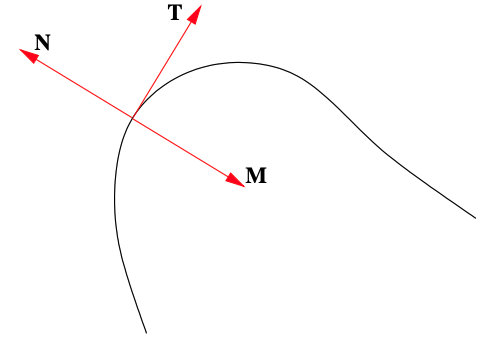2.2.E: Best Affine Approximations (Exercises)
- Page ID
- 77752
Exercise \(\PageIndex{1}\)
Find the derivative of each of the following functions.
(a) \(f(t)=\left(t^{3}, t, 2 t+4\right)\)
(b) \(g(t)=(3 t \cos (2 t), 4 t \sin (2 t))\)
(c) \(h(t)=\left(4 t^{3}-3, \sin (t), e^{-2 t}\right)\)
(d) \(f(t)=\left(e^{-t} \sin (3 t), e^{-t} \cos (3 t), t e^{-t}\right)\)
- Answer
-
(a) \(D f(t)=\left(3 t^{2}, 1,2\right)\)
(c) \(D h(t)=\left(12 t^{2}, \cos (t),-2 e^{-2 t}\right)\)
Exercise \(\PageIndex{2}\)
For each of the following, find the best affine approximation to \(f\) at the given point.
(a) \(f(t)=\left(t, t^{3}\right), t=2\)
(b) \(f(t)=(3 \sin (2 t), 4 \cos (2 t)), t=\frac{\pi}{6}\)
(c) \(f(t)=(\cos (t), \sin (t), \cos (2 t)), t=\frac{\pi}{3}\)
(d) \(f(t)=(2 \cos (2 t), 3 \sin (2 t), 3 t), t=0\)
- Answer
-
(a) \(A(t)=(1,12)(t-2)+(2,8)\)
(c) \(A(t)=\left(-\frac{\sqrt{3}}{2}, \frac{1}{2},-\sqrt{3}\right)\left(t-\frac{\pi}{3}\right)+\left(\frac{1}{2}, \frac{\sqrt{3}}{2},-\frac{1}{2}\right)\)
Exercise \(\PageIndex{3}\)
Let \(f(t)=(2 \cos (\pi t), 3 \sin (\pi t))\) parametrize an ellipse \(E\) in \(\mathbb{R}^2\). Plot \(E\) along with the tangent line at \(f\left(\frac{2}{3}\right)\).
Exercise \(\PageIndex{4}\)
Let \(f(t)=((1+2 \cos (t)) \cos (t),(1+2 \cos (t)) \sin (t))\) parametrize a curve \(C\) in \(\mathbb{R}^2\). Plot \(C\) along with the tangent line at \(f\left(\frac{\pi}{6}\right)\).
Exercise \(\PageIndex{5}\)
Let \(h(t)=\left(\sin (2 \pi t), \cos (2 \pi t), \frac{t}{2}\right)\) parametrize a circular helix \(H\) in \(\mathbb{R}^3\). Plot \(H\) along with the tangent line at \(h\left(\frac{3}{2}\right)\).
Exercise \(\PageIndex{6}\)
Let \(g(t)=(\cos (\pi t), \sqrt{t}, \sin (\pi t))\) parametrize a curve \(C\) in \(\mathbb{R}^3\). Plot \(C\) along with the tangent line at \(g\left(\frac{1}{4}\right)\).
Exercise \(\PageIndex{7}\)
Suppose \(f: \mathbb{R} \rightarrow \mathbb{R}^{2}\) is defined by \(f(t)=(t, \varphi(t))\), where \(\varphi: \mathbb{R} \rightarrow \mathbb{R}\) is differentiable, and let \(C\) be the curve in \(\mathbb{R}^2\) parametrized by \(f\). Show that the tangent line to \(C\) at \(f(c)\) is the same as the line tangent to the graph of \(\varphi\) at \((c, \varphi(c)\).
- Answer
-
Note that the tangent line to \(C\) at \(f(c)\) is parametrized by
\[ A(t)=\left(1, \varphi^{\prime}(c)\right)(t-c)+(c, \varphi(c))=\left(t, \varphi^{\prime}(c)(t-c)+\varphi(c)\right) \nonumber \]
Exercise \(\PageIndex{8}\)
Let \(C\) be the curve in \(\mathbb{R}^2\) parametrized by \(f(t)=\left(t^{3}, t^{6}\right),-\infty<t<\infty .\) Is \(f\) a smooth parametrization of \(C\)? If not, can you find a smooth parametrization of \(C\)?
- Answer
-
No, \(f\) is not a smooth parametrization of \(C\) since \(D f(0)=(0,0)\). However, \(g(t)=\left(t, t^{2}\right),-\infty<t<\infty\), is a smooth parametrization of \(C\).
Exercise \(\PageIndex{9}\)
Let \(C\) be the curve in \(\mathbb{R}^2\) parametrized by \(f(t)=\left(t^{2}, t^{2}\right),-\infty<t<\infty\). Show that \(f\) is not a smooth parametrization of \(C\). Where is the problem? Plot \(C\) and identify the location of the problem.
- Answer
-
\(f\) is not a smooth parametrization of \(C\) since \(D f(0)=(0,0)\).
Exercise \(\PageIndex{10}\)
Let \(\mathbf{v} \neq \mathbf{0}\) and \(\mathbf{p}\) be vectors in \(\mathbb{R}^n\) and let \(C\) be the curve in \(\mathbb{R}^n\) parametrized by \(f(t)=t \mathbf{v}+\mathbf{p}\). What is the best affine approximation to \(f\) at \(t=t_{0}\)?
Exercise \(\PageIndex{11}\)
For each of the following, find the unit tangent vector and the principal unit normal vector at the indicated point.
(a) \(f(t)=\left(t, t^{2}\right), t=1\)
(b) \(g(t)=(3 \sin (2 t), 3 \cos (2 t)), t=\frac{\pi}{3}\)
(c) \(f(t)=(2 \cos (t), 4 \sin (t)), t=\frac{\pi}{4}\)
(d) \(h(t)=(\cos (\pi t), 2 \sin (\pi t)), t=\frac{3}{4}\)
(e) \(g(t)=(\cos (t), \sin (t), t), t=\frac{\pi}{3}\)
(f) \(f(t)=(2 \sin (t), 3 \cos (2 t), 2 t), t=\frac{\pi}{4}\)
(g) \(f(t)=(\sin (\pi t),-\cos (\pi t), 3 t), t=\frac{1}{2}\)
(h) \(g(t)=\left(\cos \left(\pi t^{2}\right), \sin \left(\pi t^{2}\right), t^{2}\right), t=1\)
(i) \(f(t)=\left(t, t^{2}, t^{3}\right), t=2\)
- Answer
-
(a) \(T(1)=\frac{1}{\sqrt{5}}(1,2) ; N(1)=\frac{1}{\sqrt{5}}(-2,1)\)
(c) \(T\left(\frac{\pi}{4}\right)=\frac{1}{\sqrt{5}}(-1,2) ; N\left(\frac{\pi}{4}\right)=-\frac{1}{\sqrt{5}}(2,1)\)
(e) \(T\left(\frac{\pi}{3}\right)=\left(-\frac{1}{2} \sqrt{\frac{3}{2}}, \frac{1}{2 \sqrt{2}}, \frac{1}{\sqrt{2}}\right) ; N\left(\frac{\pi}{3}\right)=\left(-\frac{1}{2},-\frac{\sqrt{3}}{2}, 0\right)\)
(g) \(T\left(\frac{1}{2}\right)=\left(0, \frac{\pi}{\sqrt{9+\pi^{2}}}, \frac{3}{\sqrt{9+\pi^{2}}}\right) ; N\left(\frac{1}{2}\right)=(-1,0,0)\)
(i) \(T(2)=\frac{1}{\sqrt{161}}(1,4,12) ; N(2)=\frac{1}{\sqrt{29141}}(-76,-143,54)\)
Exercise \(\PageIndex{12}\)
Use the fact that \(f(t)=(b \cos (t), b \sin (t))\) parametrizes a circle of radius \(b\) to show that a radius of a circle is always perpendicular to the tangent line at the point where the radius touches the circle.
Exercise \(\PageIndex{13}\)
Verify (2.2.21); that is, show that if \(f: \mathbb{R} \rightarrow \mathbb{R}^{n}\) and \(\varphi: \mathbb{R} \rightarrow \mathbb{R}\) are both differentiable, then
\[D(\varphi(t) f(t))=\varphi(t) D f(t)+\varphi^{\prime}(t) f(t). \nonumber \]
Exercise \(\PageIndex{14}\)
Suppose \(f: \mathbb{R} \rightarrow \mathbb{R}^{3}\) and \(g: \mathbb{R} \rightarrow \mathbb{R}^{3}\) are both differentiable. Show that
\[ D(f(t) \times g(t))=f(t) \times D g(t)+D f(t) \times g(t), \nonumber \]
yet another version of the product rule.
Exercise \(\PageIndex{15}\)
The following figure illustrates a curve in R2 parametrized by some function \(f: \mathbb{R} \rightarrow \mathbb{R}^{2}\). If \(\mathbf{T}\) is the unit tangent vector at the indicated point on the curve, then either \(\mathbf{M}\) or \(\mathbf{N}\) is the principal unit normal vector at that point. Which one is it?

- Answer
-
\(M\)


